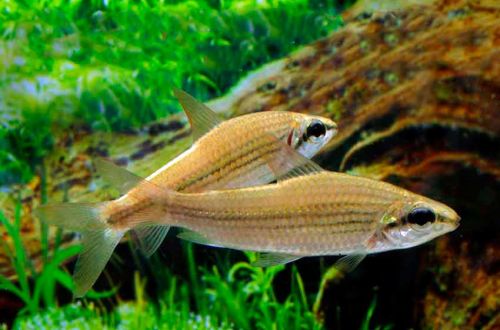
The Kurima
Kurimata, scientific name Cyphocharax multilineatus, belongs to the family Curimatidae (toothless characins). The fish is native to South America. Inhabits the upper reaches of the Rio Negro and Orinoco rivers in Brazil, Venezuela and Colombia. They are found in calm sections of rivers with many shelters, as well as in flooded areas of tropical forests during the rainy season.

Description
Adults reach a length of about 10–11 cm. Outwardly, it is very similar to Chilodus, but Kurimata is easily identified by the black stripe passing through the eyes. The rest of the coloration and body pattern are similar: light yellow shades with dark pigmentation forming horizontal lines.
Behavior and Compatibility
Peaceful moving fish. A significant part of the time is spent in search of food, looking between stones and snags. They prefer to be in the company of relatives. They get along well with other non-aggressive species of comparable size.
Brief information:
- The volume of the aquarium – from 100 liters.
- Temperature – 23-27°C
- pH value – 5.5 – 7.5
- Water hardness – 5–20 dGH
- Substrate type – soft sandy
- Lighting – moderate, subdued
- Brackish water – no
- Water movement – little or no
- The size of the fish is 10–11 cm.
- Nutrition – any feed with a significant content of plant components
- Temperament – peaceful
- Keeping in a group of 3-4 individuals
Maintenance and care, arrangement of the aquarium
The optimal size of the aquarium for a group of 3-4 fish starts from 100-150 liters. The decor is simple. It is recommended to use soft sandy soil on which to place natural snags, heaps of stones. It is permissible to place the bark and leaves of trees. The latter will need to be replaced periodically as they decompose.
The presence of thickets of plants, including floating ones, is welcome. However, you should not allow excessive overgrowth of the aquarium.
A comfortable environment is warm, soft, slightly acidic water, moderate or subdued lighting, and little or no current.
Aquarium maintenance is standard and consists of such mandatory procedures as weekly replacement of part of the water with fresh water, equipment maintenance and removal of accumulated organic waste.
Food
In nature, it feeds on algae growing on stones and snags, and the organisms living in them. Thus, the daily diet should contain a significant amount of plant components. A good choice would be popular dry food supplemented with fresh or frozen bloodworms, brine shrimp, daphnia, etc.
Sources: fishbase.org, aquariumglaser.de





